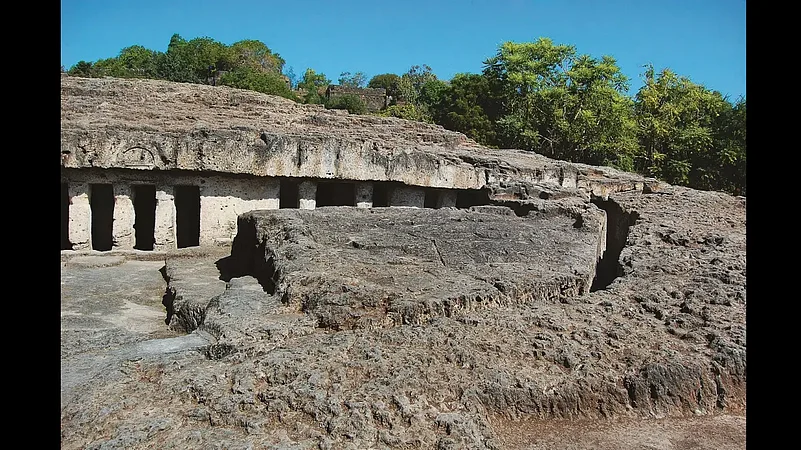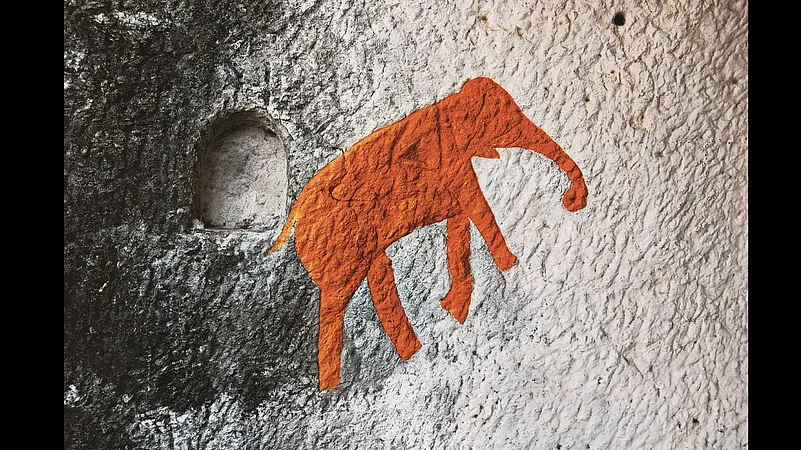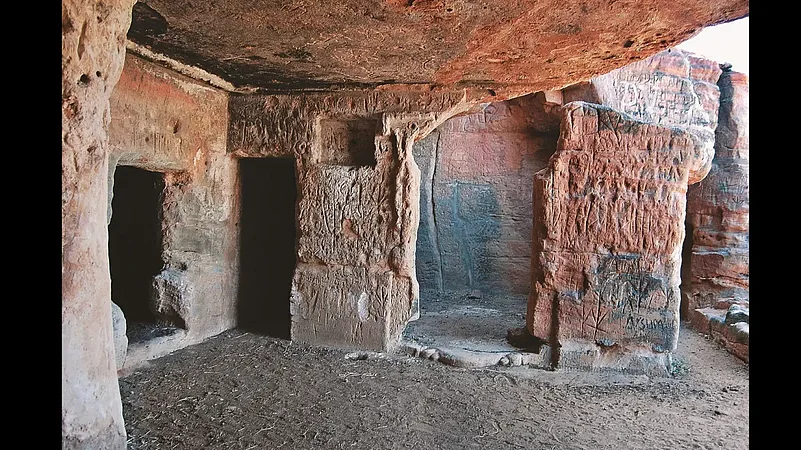When one thinks of Buddhism in the Indian subcontinent, Gujarat is not the first place that comes to mind. And yet, the state’s tryst with Buddhism dates back at least to the time of the Mauryan empire, when the religion flourished under the patronage of emperors such as Ashoka. References to Buddhism’s thriving presence in Gujarat can be found in ancient Indian and foreign literature.
Chronicles of Buddhism: Highlights of Gujarat's Buddhist Circuit
Despite its significance to Jains and Hindus, continuing archaeological discoveries have revealed the sheer extent of the spread of Buddhism in Gujarat

The 14 Ashokan rock edicts at the foot of Mount Girnar in Gujarat’s Junagadh district are perhaps the earliest archaeological evidence of Gujarat’s Buddhist connection. Carved on a granite block, they date back to the 3rd century BCE and speak of issues of religion, politics and morality, while also describing Ashoka’s transformation after the Kalinga War.
However, it is probably the Chinese traveller Xuanzang who first found evidence of Buddhist settlements in Gujarat during his Indian sojourn in 640 CE. In his journal, he mentions the presence of around 10,000 monks in 200 monasteries spread across Bharuch, Atali, Kheta, Valabhi, Anandapura and Saurashtra. Yijing, who visited India in 670 CE, notes that, of the 18 schools of early Buddhism, the Sammatiya School was the most popular in Gujarat and western India. He goes on to add that, at that time, the Valabhi University, the centre of learning for the Sammatiya Buddhists, was equal in stature and importance to the Nalanda University in Bihar.
Today, one can relive this rich and vibrant history, thanks to Gujarat Tourism’s Buddhist Circuit. The circuit takes one past ancient pillars, stupas, viharas with their ornate engraving and exquisite rock-cut caves that must have been immensely significant to the people centuries ago. In the process, it also covers a large portion of Gujarat—Kutch, Bharuch, Saurashtra and Junagadh are some of the major stopovers.

The highlights of Gujarat’s Buddhist Circuit include:
Ashoka Edicts
As previously mentioned, the 14 Ashokan edicts at the base of Mount Girnar in Junagadh are the among earliest signs of the spread of Buddhism in Gujarat. Written in Pali in the Brahmi script, the edicts date back to 250 BCE. They preach the need of universal values such as turning a blind eye to greed and animal sacrifice, maintaining purity of thought, practising secularism, kindness and gratitude, respecting others and creating a just society. And even though the Buddha is mentioned in the edicts, Ashoka’s lessons cut across religions and creeds—many of them still hold true today.
Baba Pyare Caves

The Baba Pyare caves (also known as Bava Pyara caves or Baba Pyara caves) fall under the Junagadh Group of Caves, a cluster that also includes the Khapra Kodiya caves and the Uparkot caves. The Baba Pyare caves lie just outside the Uparkot Fort close to Modhimath and extend both in north-south and east-west directions. These man-made caves, carved in rock 45 metres high, consist of 13 rooms in three storeys and are divided into three lines. The first line lies to the north and has four south-facing chambers. The second line to the south branches from the eastern end of the first line is more spacious and boasts of a court and a?chaitya?hall (prayer hall) surrounded by cells on both its sides. The third line at the back of the second is built in a west-north-west direction. The pillars and door jambs in these caves bear influences of the art traditions of the Satavahanas, while carvings from Buddhist symbology can be seen on the walls of the cells. According to James Burgess, the well-known English archaeologist from the 19th century, the caves, which probably go back to the 2nd or 3rd century CE, initially housed Buddhist?bhikkhus. Later, Jain ascetics also came to live here, which is why the caves are sacred to the Jains as well.
Buddhist Caves of Khapra Kodiya

The oldest among the Junagadh Group of Caves and the earliest monastic settlement in the area, the Khapra Kodiya caves were built between the 3rd and 4th centuries BCE. Their construction, in all likelihood, happened during Ashoka’s reign. Located to the north of the Uparkot Fort complex on the edge of the Sudarshan Lake (which no longer exists), these caves are the plainest-looking in the whole of Junagadh. The quarters were split along a longitudinal, east-west axis—the oblong wing in the west and the L-shaped wing which the monksused as a monsoon shelter are its most distinctive features. And while the caves once had a water tank, water seepage and widening cracks gradually forced the monks to abandon the caves and migrate to Maharashtra.
Dev Ni Mori

Post independence, archaeological excavations at Dev Ni Mori in the Aravalli district in the 1950s yielded a treasure trove of Buddhist artifacts. These include terracotta sculptures, relics, caskets, coins and artworks which have a blend of Buddhist, Hindu and Muslim styles according to the era they belong to. Dev Ni Mori is also the site of a?stupa?(which is home to nine images of the Buddha designed in the Greco-Buddhist style) and a?vihara?which were built in a style common to Buddhist settlements in the north-western portions of the subcontinent and which would gradually spread all over the country. However, its most prized possession is possibly a casket, excavated from the?stupa, with an inscription that clearly states that it contains the bodily relics of the Buddha.
Kadia Dungar Buddhist Caves

Seven rock-cut caves were discovered at the Kadia Dungar Hill in Bharuch district in central Gujarat. Carved out in the 1st and 2nd centuries AD, their construction suggests that they were probably conceived as?viharas. At this site, one can also find a sculpture of the Buddha’s feet, monolithic lion pillars and a brick?stupa?at the base of the hill.
Khambhalida Buddhist Caves
The distinctive feature of the Khambhalida Caves in Gujarat’s Rajkot district is that they are carved in limestone rocks.The Khambhalida site, discovered by renowned Indian archaeologist P. P. Pandya in 1958, has three major caves and 15 others in close proximity. They were made sometime in the 4th or 5th century CE on the banks of a spring flowing close to the foot of a hillock. Of all the caves, it’s the one at the centre of the three major ones that grabs the most eyeballs.It has a?stupa?or a?chaitya griha?in its depths, the entrance to which is flanked by sculptures of bodhisattvas. The figure to the left is probably that of Padmapani (one of the 108 avatars of Avalokiteshvara) with a female companion and attendants, while the one on the right shows Vajrapani (another bodhisattva) with attendants. The sculptures show similarities with the Kushana and Western Kshatrapa art styles.
Advertisement
Siyot Caves

From Rajkot, we move to the Kutch district where one finds the Siyot caves in the Lakhpat?taluka. The caves, also called the Kateshwar Buddhist Caves, were proven to have Buddhist occupancy, thanks to the findings from the excavations carried out in 1988-1989. Clay seals—some showing the Buddha in various?mudras, others having inscriptions in Brahmi and Devanagari—were unearthed, in addition to coins, terracotta statues, copper rings and different forms of earthenware. Out of the five rock-cut caves, the main one has a sanctum and spaces for walking; the others being simple, single cells. It is believed that the five caves were part of the 80 Buddhist caves near the mouth of the Indus, which find mention in Xuangzang’s chronicles from the 7th century CE.
Advertisement
Talaja Hills

Cut into the conical rocks of a hill in Talaja in Bhavnagar district are 30 caves—a mix of?chaitya?halls, water tanks and ordinary cells. However, the pièce de résistance of this group of caves is the Ebhala Mandapa—a large hall with four octagonal pillars. The cells and the bodhisattva sculptures in them bear marks of Buddhist architecture from the 2nd century BCE—a period prior to when Buddhist rock-cut architecture makes its presence felt in neighbouring Maharashtra.
Taranga Caves

Advertisement
Excavations and archaeological excavations at Taranga Hills in Mehsana district, known for its Jain temples, continue to spring surprises. A cave locally known as Jogida ni Gufa is said to have been used by Buddhist monks thousands of years before. The same cave contains stone sculptures of the Buddha designed with Bodhi Vriksha, Kalpavriksha and other Buddhist paths. The mountain path leading to the cave is dotted with similar structures. Nearby, the Dharanmata and Taranmata temple are dedicated to the Buddhist?tantric?goddess Tara, and in the vicinity of the temples, terracotta images of the Buddha and carvings of Dhyani Buddha have also been discovered. And over the past decade, nearly 40 small burnt-brick?stupas?have been found at the base of Taranga and neighbouring hills, thereby elevating its status in the state’s Buddhist circuit.
Advertisement
Uparkot Caves
The Buddhist settlement in the Uparkot caves can be found near Adi Kadi Vav, a stepwell in the magnificent Uparkot Fort dug out of solid rock. The caves, going back to the 2nd or 3rd century CE, show a blend of influences from the architecture of the Satavahanas and the Greco-Scythian styles. The caves, which are divided into two floors, boast of some of the most exquisitely and intricately designed pillars among the Junagadh Group of Caves. The first floor contains a deep?kund?(tank) surrounded by covered verandas on three sides. Both floors of caves showcase similar architectural features—stone-benched recesses divided into long compartments,?vihara?cells for meditation by the monks, ornate and beautifully designed pillars and horseshoe-shaped chaitya windows.
Advertisement
Vadnagar

Discoveries over the past two years have put Vadnagar in Mehsana district firmly on Gujarat’s Buddhist circuit map. In the 2000s, archaeologists had unearthed a monastery in the Ghaskol locality of town with?stupas, an open courtyard with surrounding cells in a pattern that resembled a swastika. ASI’s findings in 2020 and 2021 undertaken by the Excavation Branch in Vadnagar have revealed more treasures. A circular structure, probably a?stupa, being exposed on the southern side of Sharmistha Lake seems to be one of the significant finds—it has been built of burnt bricks. ASI’s discoveries here in 2021 have a definite connection with Dev Ni Mori’s treasures—a curious elliptical structure near the town boundary (which experts believe was used for congregation purposes or to house a shrine), various artefacts and a sealing with the same words as the casket bearing Buddha’s remains in Dev Ni Mori.
Advertisement
-
Previous Story
 Tom Holland Recalls ‘Trip Of A Lifetime' Visiting India With Girlfriend Zendaya
Tom Holland Recalls ‘Trip Of A Lifetime' Visiting India With Girlfriend Zendaya - Next Story


















